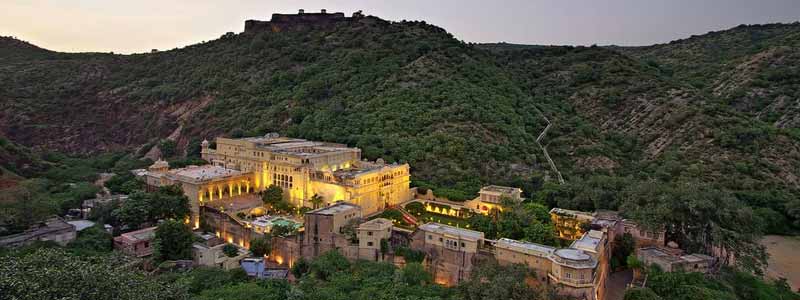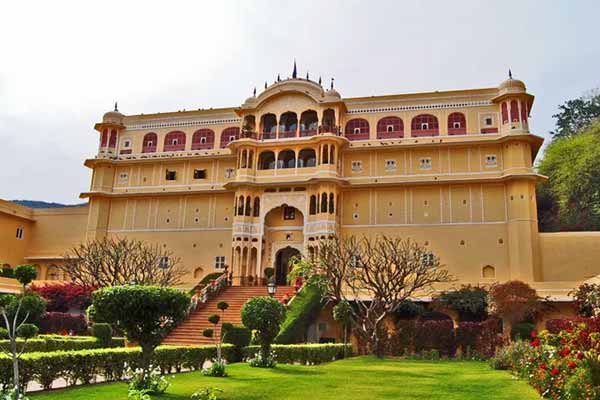Samode Palace Jaipur perfectly blends the beauty of traditional Indian art and culture with the luxury of a modern hotel, set among the raw grandeur of the Rajasthani landscape.
The former home of a Rajasthani prince, Samode Palace is a stunning heritage hotel that has been beautifully restored to provide a retreat from the modern world where visitors can explore India’s natural beauty and rich history. With its traditional design, focusing on rich fabrics of red and gold, mosaic floors, stained glass windows, and intricately carved wooden furniture, it feels like a place adrift in time.
Dine on the finest local cuisine in the Royal Rajasthan, where spices hang in the the air, or enjoy the sumptuous buffet. Indulge in a spa treatment at the Kerala Ayurvedic Center. Or simply wander from hall to hall under ornate arches, sit in the central courtyard amidst chirping birds and the soothing sound of water of the marble fountain, or lounge by the ornate pool, taking in the beauty around you Samode Tour.

History
Samode Palace Jaipur is a large town in Rajasthan, which belonged to the landlords known as ‘zamindars’ of the state of Amber. Samode was, even then, considered a very rich town under the kingdom of Amber. Behari Das, a Rajput warrior who was then in Mughal service of the Nathawat clan and inherited the Zamindari of Samode. It was under the British Raj but was restored to the Nathawat clan with the hereditary title ‘Rawal Saheb’ or ‘Maha Rawal’ in 1757, and this lineage is continued to this date Rajasthan Monuments.
Samode Palace was initially built in the 16th century as a Rajput fort, but in the early 19th century, under the nobleman Rawal Berisal, it was converted from a fort into an exquisitely designed palace. Rawal Sheo Singh, the descendant of Rawal Berisal, who was the Prime Minister of Jaipur state for several years, during the middle of the 19th century, further expanded the Palace by adding the Darbar Hall and the Sheesh Mahal. In 1987, it was converted into the heritage “Samode Palace Hotel”.
Samode Palace Jaipur was also built by Rawal Sheo Singh more than 150 years ago. It was built as a resort for the royal family.
Major Attractions
Samode Fort: The Fort stands on a hill above the Samode Palace Jaipur. This used to be the raja’s former residence before Samode Palace was built. The fort also has 300 steps which will lead to a secret underground passage, which was used during times of emergency. From the top of the fort, you can enjoy a panoramic view of the village. Walking among the ruins and the surroundings make one feel as if one is in another era.
Samode Bagh: This is a traditional garden similar to Kashmiri gardens built by Rawal Sheo Singh, a scion of the Nathawat clan of Rajputs. Famous for its collection of Mughal arts inside tents. The decorative fountain and watercourse look magnificent with water.
Samode Haveli: Haveli is the local name for ancient mansions built for top ministers in the royal court. The mansion is five centuries old and was built and used by Prime minister of royal court, Rawal Singhji. At Samode Palace Jaipur, you will find a spa bath and fitness hub, magical performances like puppet shows, Rajasthani music, and dance performances.
Govind Devji Temple: This Krishna temple is an important pilgrimage site, which is famous for rituals and architecture. If you are visiting this temple, do not forget your camera. This is one of the photogenic spots in the village. The temple is dedicated to Govind Dev Ji (Lord Krishna). The image of the deity (murti) was brought from Vrindavan here by Raja Sawai Jai Singh II, the founder of Jaipur.
Shekhawati: Shekhawati is a small village, a little away from the village of Samode Palace Jaipur. History has it that in the 17th to 19th centuries, Marwari merchants constructed these grand havelis in the Shekhawati region. This village provides numerous activities like camel ride, folk dance and music, and others. You can spot numerous havelis with murals and paintings in this region Rajasthan Budget Tours.
Local Markets: One can enjoy camel ride through the markets, a musical evening with folk performances and much more. This is the best place to do some souvenir shopping for fiddles, goatskin bagpipe, country violins, an instrument made with a dried gourd, camel skin articles and much more
Best Time To Visit
The best time to visit Samode is from October-March.
Samode is a large town in Rajasthan which is renowned for the Samode Palace Jaipur, Garden and Palace. Since the climate here is arid and the plains are desert-like, the best way to explore the town would probably be on the back of a camel, with the breathtaking views of the country side and the remnants of a royal era in the backdrop.
How To Reach Samode Palace
Samode Palace Jaipur is placed is about 42 km from capital city Jaipur. One can easily reach here by Air, Railway, and Bus by the following means:
By Air: Nearest airport to the Samode Palace Jaipur International Airport (JAI). The Palace is distanced 56 km away and one can take any public transport to reach the destination within 1 hour 15 minutes.
By Railway: Nearest Railway Station is Jaipur Junction from where the Palace is 39.6 km away. Thus, one can reach there within 1 hour.
By Bus: One can easily take up a bus to Jaipur which will stop at the main bus stop at Jaipur Bus Stand at Jawahar Nagar Marg and can reach the Palace via any public transport in 1 hour 20 minutes by covering a distance of 62 km.
